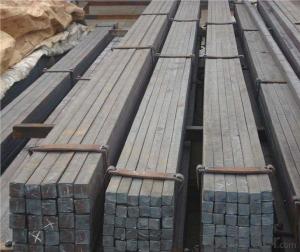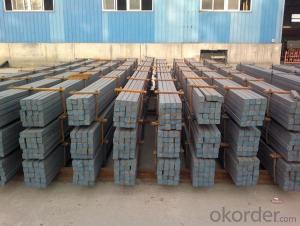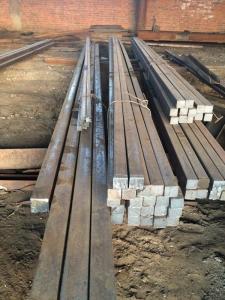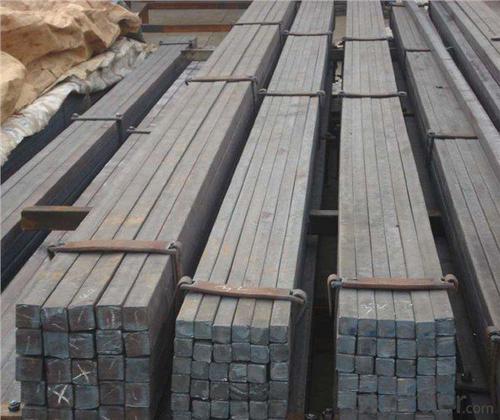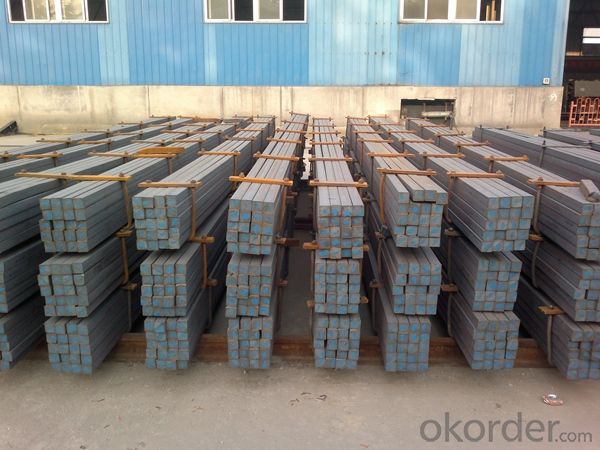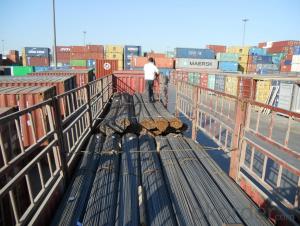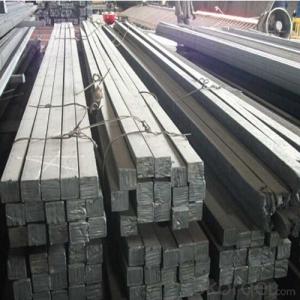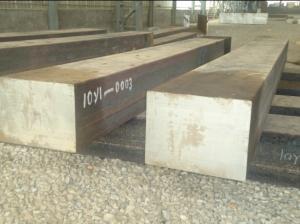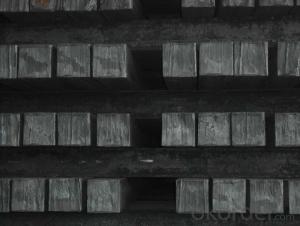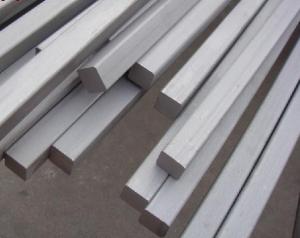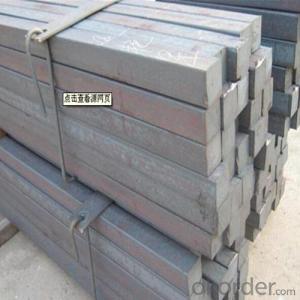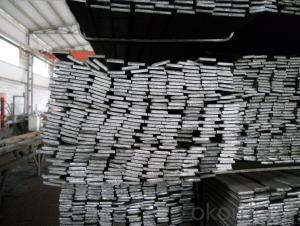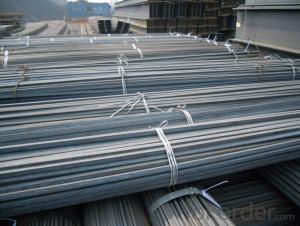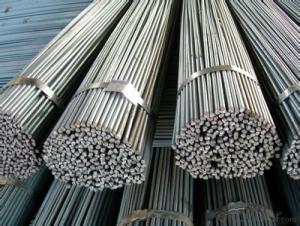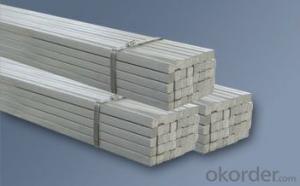Hot Rolled Square Bar Steel for Constrcution
- Loading Port:
- Tianjin
- Payment Terms:
- TT or LC
- Min Order Qty:
- 25 m.t.
- Supply Capability:
- 200000 m.t./month
OKorder Service Pledge
OKorder Financial Service
You Might Also Like
Product Description:
OKorder is offering Hot Rolled Square Bar Steel for Constrction with worldwide shipping. Our supplier is a world-class manufacturer of steel, with our products utilized the world over. OKorder annually supplies products to European, North American and Asian markets. We provide quotations within 24 hours of receiving an inquiry and guarantee competitive prices.
Product Applications:
-The Hot Rolled Square Bar Steel for Constrction is normally used as structure steel.
-Row material for other structure steel like steel angles, channels, I-beams, H-beams, etc…
Product Advantages:
OKorder's Hot Rolled Square Bar Steel for Constrction are durable, strong, and resist corrosion. Ang they satisfy the requirements of dififrent customers.
Main Product Features:
· Premium quality
· Prompt delivery & seaworthy packing (30 days after receiving deposit)
· Corrosion resistance
· Can be recycled and reused
· Mill test certification
· Professional Service
· Competitive pricing
Product Description of Hot Rolled Square Bar Steel for Constrcution:
Specifications of Hot Rolled Square Bar Steel for Constrcution:
-Standard: GB,
-Grade: Q195/Q235 or equivalent.
Chemical Composition:
-Chemical Composition. Q195
Standard | Grade | Element (%) | ||||
GB | Q195 | C | Mn | S | P | Si |
0.06~0.12 | 0.25~0.50 | ≤0.050 | ≤0.045 | ≤0.30 | ||
-Chemical Composition. Q235
Standard | Grade | Element (%) | ||||
GB | Q235B | C | Mn | S | P | Si |
0.12~0.20 | 0.30~0.70 | ≤0.045 | ≤0.045 | ≤0.30 | ||
Measures and Tolerances of Hot Rolled Square Bar Steel for Constrcution:
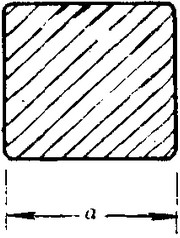
(The section of Hot Rolled Square Bar Steel for Constrcution)
-The length of a side and the theoretical weight of Hot Rolled Square Bar Steel for Constrcution.
Length of a side(a, mm) | Theoretical weight(kg/m) | Length of a side(a, mm) | Theoretical weight(kg/m) |
6 | 0.283 | 32 | 8.04 |
7 | 0.385 | *33 | 8.55 |
8 | 0.502 | 34 | 9.07 |
9 | 0.636 | *35 | 9.62 |
10 | 0.785 | 36 | 10.17 |
11 | 0.950 | 38 | 11.24 |
12 | 1.13 | 40 | 12.56 |
13 | 1.33 | 42 | 13.85 |
14 | 1.54 | 45 | 15.90 |
15 | 1.77 | 48 | 18.09 |
16 | 2.01 | 50 | 19.63 |
17 | 2.27 | 53 | 22.05 |
18 | 2.54 | *55 | 23.6 |
19 | 2.82 | 56 | 24.61 |
20 | 3.14 | *58 | 26.4 |
21 | 3.46 | 60 | 28.26 |
22 | 3.80 | 63 | 31.16 |
*23 | 4.15 | *65 | 33.17 |
24 | 4.52 | *68 | 36.3 |
25 | 4.91 | 79 | 38.49 |
26 | 5.30 | 75 | 44.16 |
*27 | 5.72 | 80 | 50.24 |
28 | 6.15 | 85 | 56.72 |
*29 | 6.60 | 90 | 63.59 |
30 | 7.06 | 95 | 70.85 |
*31 | 7.54 | 100 | 78.50 |
Notes:
1, The theoretical weights in the list, base on the density of 7.85 g/cm3.
2, The numbers with *mean that they are not regulars or we don’t offer them.
-The allowed tolerance of Square Steel:
Length of a side(mm) | Allowed Tolerance | ||
Group1 | Group2 | Group3 | |
5.5~7 | ±0.20 | ±0.30 | ±0.40 |
7~20 | ±0.25 | ±0.35 | ±0.40 |
20~30 | ±0.30 | ±0.40 | ±0.50 |
30~50 | ±0.40 | ±0.50 | ±0.60 |
60~80 | ±0.60 | ±0.70 | ±0.80 |
80~110 | ±0.90 | ±1.0 | ±1.1 |
110~150 | ±1.2 | ±1.3 | ±1.1 |
150~190 | ―― | ―― | ±2.0 |
190~250 | ―― | ―― | ±2.5 |
Packaging & Delivery of Steel Square Bar:
-Packing Detail: The products can be packed in bundles by steel wires.
-Marks:
1, Tag marks: the tag marks will be tied up to each bundle of the products. The information is usually including supplier’s logo and name, product name, made in China, products’ specifications, the painted color and other information requested by customers.
2, Color marks: we will paint both ends of the bundles of these products to make sure that they are more evident. It’s will be more convenient for the customers to distinguish them at the destination port.
-Delivery Detail: 30~45 working days after receive buyer’s T.T. or L/C.
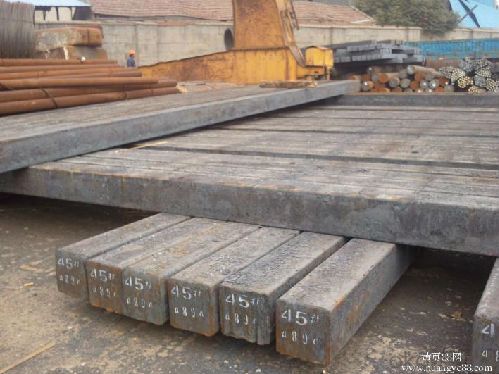
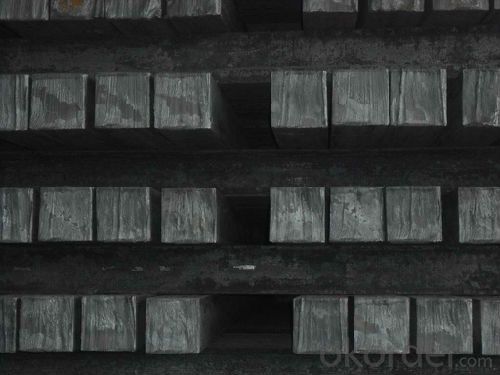
FAQ:
Q1: The products are invoicing on theoritical weight or on actual weight?
A1: We can do it in both manners, according to the customers' request.
Q2: How soon can we receive the product after purchase?
A2: Within three days of placing an order, we will begin production. The specific shipping date is dependent upon international and government factors, but is typically 7 to 10 workdays.
Q3: How do we guarantee the quality of our products?
A3: We have established an advanced quality management system which conducts strict quality tests at every step, from raw materials to the final product. At the same time, we provide extensive follow-up service assurances as required.
- Q: How do you use a steel square to lay out a circle?
- To use a steel square to lay out a circle, you will need to follow a few steps. First, determine the diameter or radius of the circle you want to lay out. The diameter is the distance across the circle, while the radius is the distance from the center to any point on the circle. Next, position the steel square with one edge aligned along the diameter or radius line. Ensure that the square is securely held in place so that it does not move during the process. Then, locate the 90-degree angle of the steel square, which is the corner where the two arms of the square meet. This angle will serve as the starting point for laying out the circle. Using the 90-degree angle as a pivot point, rotate the steel square smoothly along the diameter or radius line. While rotating, mark several points along the circumference of the circle with a pencil or a marker. The number of points you mark will depend on the accuracy and smoothness of the rotation. Once you have marked enough points along the circumference, connect these points with a curved line to form the outline of the circle. You can use a compass or a flexible curve ruler to ensure a smooth and accurate curve. Lastly, double-check the measurements and make any necessary adjustments to ensure the circle is properly laid out. This includes verifying the accuracy of the diameter or radius and checking the smoothness of the curve. By following these steps, you can effectively use a steel square to lay out a circle with precision and accuracy.
- Q: Can a steel square be used for checking the alignment of a table router fence?
- Indeed, one can utilize a steel square to verify the alignment of a table router fence. The steel square boasts exceptional precision and reliability, rendering it suitable for assessing the perpendicularity of two surfaces. By positioning the steel square adjacent to both the fence and table of the router, it becomes feasible to ascertain whether the fence is flawlessly perpendicular to the table or necessitates adjustment. This aspect holds utmost significance in guaranteeing precise and uniform cuts when employing a table router.
- Q: How do you use a steel square to determine the angle of a spindle sanding cut?
- To use a steel square to determine the angle of a spindle sanding cut, follow these steps: 1. Place the steel square on a flat surface, such as a workbench, with one leg of the square against the edge of the surface. 2. Position the spindle sander next to the steel square, making sure it is aligned with the leg of the square. 3. Adjust the angle of the spindle sander to the desired cutting angle. You can do this by loosening the angle adjustment knob or lever on the sander and tilting it until it aligns with the leg of the steel square. 4. Once the spindle sander is aligned with the steel square, tighten the angle adjustment knob or lever to secure the desired cutting angle. 5. You can now use the steel square as a reference point to determine if the spindle sander is at the correct angle for your sanding cut. Place the edge of the steel square against the spindle sander and visually check if the sander's angle aligns with the square's leg. By using a steel square in this manner, you can ensure that your spindle sander is set at the desired angle for accurate and consistent sanding cuts.
- Q: How do you use a steel square for creating accurate half-lap joints?
- For achieving precise half-lap joints, follow these steps by utilizing a steel square: 1. Begin by measuring and marking the desired dimensions of the half-lap joint on the wooden pieces that will be joined together. It is crucial to ensure that the marks are accurate and properly aligned. 2. Place the steel square on the edge of one of the wooden pieces, aligning one of its edges with the wood's edge. It is important to hold the square firmly in its position. 3. Employ a pencil or marking knife to trace along the inner edge of the square onto the wood. This action will transfer the square's 90-degree angle onto the wood, which is essential for creating a precise half-lap joint. 4. Repeat the aforementioned tracing process on the other wooden piece that will be involved in the half-lap joint. Be certain that the marks align with those on the first piece of wood. 5. Now, utilizing a saw, carefully cut along the marked lines on both wooden pieces. It is imperative to stay as close to the marked lines as possible to guarantee a tight and accurate fit for the half-lap joint. 6. Once the cuts are completed, test-fit the two wooden pieces together. They should fit snugly, resulting in a seamless joint. If necessary, make slight adjustments using a chisel or sandpaper to achieve a flawless fit. By utilizing a steel square, one can guarantee accurately marked and cut half-lap joints, leading to strong and precise connections between the wooden pieces.
- Q: Can a steel square be used for measuring the height of a building?
- Accurately measuring the height of a building cannot be done with a steel square. The steel square, also called a framing square, is a measuring tool commonly used in carpentry and woodworking. It consists of two arms, one shorter and one longer, joined together at a 90-degree angle. While the steel square is ideal for measuring and marking angles, it is not designed to measure vertical distances. For measuring the height of a building, specialized tools like a laser level, a theodolite, or a total station are more suitable. These instruments are specifically designed for measuring vertical heights and provide precise and accurate results. They utilize techniques such as lasers or optical measurements to determine the building's height by measuring the angle of elevation or directly measuring the distance from the base to the top. In conclusion, although the steel square is versatile for certain construction and woodworking tasks, it is not appropriate for measuring the height of a building. To ensure accurate measurements, it is important to use the appropriate instruments designed specifically for this purpose.
- Q: Can a steel square be used for making parallel lines?
- Yes, a steel square can be used for making parallel lines. A steel square is a versatile tool that consists of a straight edge and a right angle. By aligning the straight edge of the steel square with a reference line, it can be used to draw another line parallel to the reference line. The right angle of the steel square ensures that the new line is perpendicular to the reference line, thereby creating parallel lines. This makes the steel square a useful tool for various applications such as carpentry, construction, and drafting.
- Q: How do you use a steel square to measure and mark out crosscuts?
- To measure and mark out crosscuts using a steel square, the following steps are typically followed: 1. Start by setting up your workpiece securely on a workbench or saw horses, ensuring it is clamped or held in place. 2. Measure and mark the desired length of the crosscut on the edge of the workpiece using a measuring tape or ruler. 3. Position the steel square against the edge of the workpiece, making sure the long arm touches the edge and the short arm extends over the face of the workpiece. 4. Align the square by adjusting its position until the long arm is parallel to the marked line on the edge of the workpiece. 5. Mark the exact location of the crosscut by using a pencil or sharp knife to draw a line along the edge of the steel square's short arm, extending across the face of the workpiece. 6. Ensure accuracy by double-checking your measurements before proceeding with the cut. If necessary, make any adjustments to the position of the steel square. 7. Finally, make the crosscut carefully using a suitable saw, such as a handsaw or circular saw. Remember to follow safety precautions and use the appropriate technique for the particular saw you are using. By following these steps, you can achieve precise and accurate crosscuts by effectively utilizing a steel square.
- Q: Can a steel square be used for checking the squareness of shelf brackets?
- Yes, a steel square can be used for checking the squareness of shelf brackets. A steel square is a versatile tool that is commonly used in carpentry and woodworking to check the accuracy of right angles. By placing the steel square against the corner of the shelf bracket, you can verify if it is perfectly square or if any adjustments need to be made. The steel square's straight edge can also be used to ensure that the bracket is aligned properly with the shelf or wall. Overall, a steel square is an effective tool for checking the squareness of shelf brackets.
- Q: How do you use a steel square to measure and mark 348.75-degree angles?
- To measure and mark 348.75-degree angles using a steel square, you would first align one edge of the square with the desired reference line. Then, rotate the square until the desired angle (348.75 degrees) is reached, making sure that the reference edge remains fixed. Finally, use a pencil or marking tool to mark the angle on the workpiece using the square as a guide.
- Q: Can a steel square be used for laying out a fence?
- Certainly! A fence can indeed be laid out using a steel square. Known by several names such as framing square or carpenter's square, a steel square is a versatile tool suitable for diverse construction and layout assignments. In terms of fence installation, a steel square proves particularly handy in guaranteeing precision and alignment. Its functions include determining right angles, measuring distances, and aligning posts and panels. Thanks to its robust build and accurate measurements, a steel square stands as an invaluable asset for both professionals and DIY enthusiasts when it comes to fence installation.
Send your message to us
Hot Rolled Square Bar Steel for Constrcution
- Loading Port:
- Tianjin
- Payment Terms:
- TT or LC
- Min Order Qty:
- 25 m.t.
- Supply Capability:
- 200000 m.t./month
OKorder Service Pledge
OKorder Financial Service
Similar products
Hot products
Hot Searches
Related keywords
